The Mining Trucks Market is estimated to be valued at USD 25.3 billion in 2025 and is projected to reach USD 43.2 billion by 2035, registering a compound annual growth rate (CAGR) of 5.5% over the forecast period.
Early growth is strongest in emerging regions with high mineral extraction and industrial investments, where infrastructure development and fleet modernization drive accelerated adoption. These regions experience a sharper year-on-year growth curve due to new project launches and supportive regulatory policies.
In contrast, mature mining markets show moderate expansion, constrained by established fleets and slower replacement cycles. Growth is driven by technology upgrades, fuel efficiency improvements, and specialized applications, resulting in a flatter growth trajectory. Over time, the disparity becomes more evident. Emerging regions continue to register rapid uptake as exploration projects and industrial activity rise, while developed markets maintain steady but incremental gains. The regional growth imbalance reflects differences in resource availability, industrial expansion, regulatory support, and replacement demand across global mining landscapes.
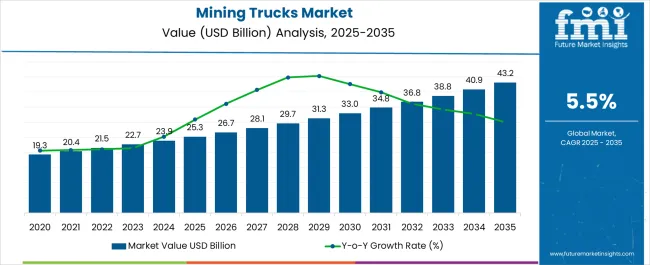
| Metric | Value |
|---|---|
| Mining Trucks Market Estimated Value in (2025 E) | USD 25.3 billion |
| Mining Trucks Market Forecast Value in (2035 F) | USD 43.2 billion |
| Forecast CAGR (2025 to 2035) | 5.5% |
The mining trucks market is witnessing robust expansion due to increased investment in mining automation, rising demand for high volume material transportation, and a continued focus on operational safety and cost efficiency. Companies are prioritizing equipment that can operate in remote or hazardous environments without compromising productivity.
The growing availability of smart fleet management systems and advancements in sensor integration are enabling real time monitoring, predictive maintenance, and optimized routing. Moreover, the pressure to reduce carbon emissions is encouraging manufacturers to invest in fuel efficient and hybrid drivetrains, enhancing the market outlook.
Mining operators across both developed and developing regions are replacing legacy fleets with technologically enhanced trucks to meet regulatory and production benchmarks, contributing to the sustained growth of this market.
The mining trucks market is segmented by mode of operation, truck type, payload capacity, propulsion, and geographic region. By mode of operation of the mining trucks market is divided into Autonomous and Manual. In terms of trucks, the mining trucks market is classified into Rigid frame haul trucks, Articulated haul trucks, Off-highway trucks, and Underground mining trucks. Based on payload capacity, the mining trucks market is segmented into Less than 100 tons, 100-200 tons, 200-300 tons, and above 300 tons. By propulsion, the mining trucks market is segmented into Diesel, Hybrid electric, and Others. Regionally, the mining trucks industry is classified into North America, Latin America, Western Europe, Eastern Europe, Balkan & Baltic Countries, Russia & Belarus, Central Asia, East Asia, South Asia & Pacific, and the Middle East & Africa.
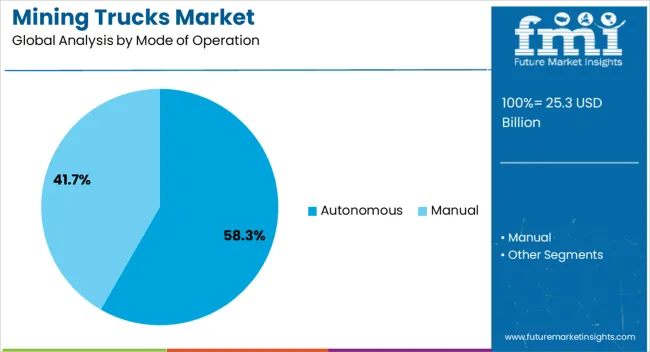
The autonomous segment is expected to account for 58.30% of the total market revenue by 2025 within the mode of operation category, making it the leading segment. This growth is attributed to the increasing demand for operational safety, labor cost reduction, and consistent productivity in harsh mining environments.
Autonomous trucks enable uninterrupted 24/7 operations with reduced human error, making them ideal for large-scale mining activities. The integration of GPS tracking, LiDAR, AI-based decision systems, and advanced telematics has further enhanced the reliability and adaptability of these trucks.
As mining companies continue to digitize operations and prioritize workforce safety, autonomous mining trucks are being deployed more widely, especially in high-capacity and remote mining sites.
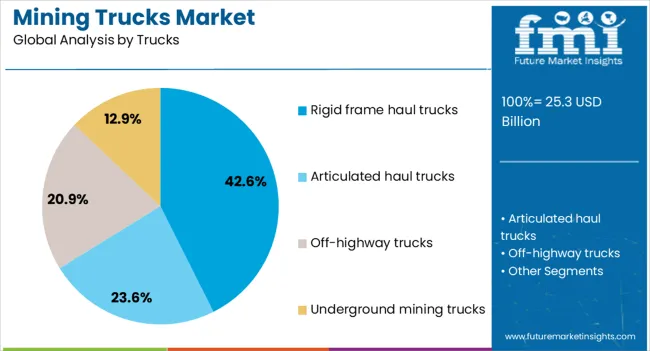
Rigid frame haul trucks are projected to hold 42.60% of total market revenue by 2025 within the truck type category, establishing them as the most prominent segment. Their dominance is driven by their structural strength, durability, and ability to carry large payloads over long distances in demanding terrains.
These trucks are heavily utilized in large open pit mines where consistent haul cycles and rugged performance are essential. The design supports high load capacities with minimal frame flexing, which contributes to improved fuel efficiency and lower maintenance requirements.
Their reliability under extreme operating conditions has positioned them as the preferred choice in large scale mining operations, reinforcing their market leadership.
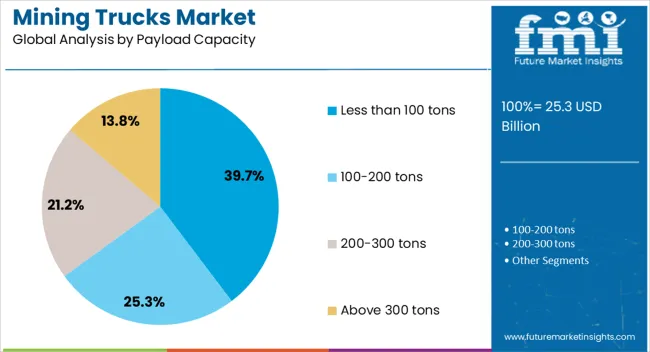
The less than 100 tons payload capacity segment is projected to contribute 39.70% of the overall revenue by 2025 under the payload capacity category, making it the leading capacity range. This dominance is driven by their cost effectiveness, versatility, and suitability for small to mid sized mining operations.
These trucks offer flexibility in navigating narrow or constrained mining sites and are preferred for operations with limited infrastructure or capital expenditure. Their lower fuel consumption and ease of maintenance make them attractive for emerging markets and junior mining firms.
As small scale mining activities continue to expand across Africa, Latin America, and parts of Asia, demand for trucks in this payload category is expected to remain strong, maintaining its position as the top performing segment.
The mining trucks market is set for growth, fueled by increasing global demand for minerals and mining efficiency improvements. Opportunities in automation and electrification are driving innovation, while challenges like cost and regulatory compliance remain key considerations.
The mining trucks market is primarily driven by the increasing global demand for minerals and natural resources. As mining operations expand to meet the needs of industries such as energy, construction, and manufacturing, the demand for efficient, heavy-duty trucks to transport mined materials grows. The expansion of mining activities, particularly in emerging economies, is fueling market demand. Additionally, the shift toward larger, more efficient mining fleets to improve productivity and reduce operational costs is also a significant growth factor. Governments are increasing investments in infrastructure development, further driving the need for mining trucks to support large-scale operations in remote areas.
The mining trucks market faces several challenges, such as high capital costs and maintenance requirements, which can deter small and mid-sized operators from upgrading their fleets. The mining industry is often subject to volatile commodity prices, affecting demand for mining trucks and other mining equipment. Regulatory challenges, including stricter environmental regulations and safety standards, add complexity to truck design and manufacturing. High fuel consumption and maintenance costs are also persistent issues for mining truck owners, requiring manufacturers to develop more efficient and cost-effective models. These factors can slow the growth of the mining truck market, especially in cost-sensitive regions.
The mining trucks market presents numerous opportunities, especially with the ongoing shift toward automation and electrification. Automated and electric mining trucks are gaining traction as companies seek to reduce labor costs and improve environmental performance. The development of electric-powered mining trucks presents a new revenue stream, driven by demand for reduced emissions and fuel costs. The growing focus on optimizing operational efficiency through fleet management and real-time tracking systems opens up opportunities for manufacturers to offer integrated solutions. The continued expansion of mining activities, particularly in Africa and Latin America, further boosts the demand for specialized mining trucks.
The future of the mining trucks market looks promising, driven by increasing demand for raw materials and ongoing infrastructure development in emerging regions. The market is expected to benefit from innovations such as autonomous vehicles, which can improve safety and efficiency in mining operations. Electric mining trucks are set to play a key role in meeting stricter emissions standards, particularly in regions with stringent environmental regulations. The continuous expansion of mining operations globally, along with increased investments in technological solutions to optimize truck performance and reduce operating costs, will drive steady market growth.
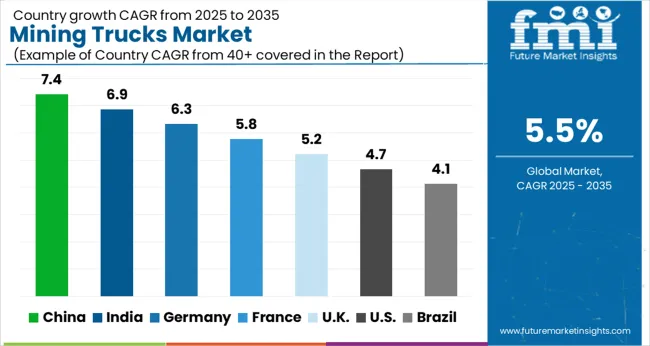
| Countries | CAGR |
|---|---|
| China | 7.4% |
| India | 6.9% |
| Germany | 6.3% |
| France | 5.8% |
| UK | 5.2% |
| USA | 4.7% |
| Brazil | 4.1% |
The mining trucks market is expected to grow globally at a CAGR of 5.5% from 2025 to 2035, driven by expanding mining operations and infrastructure development. China leads with a CAGR of 7.4%, propelled by its growing resource extraction activities, large-scale infrastructure projects, and rising demand for heavy-duty equipment. India follows at 6.9%, supported by its increasing mining and construction activities, alongside government initiatives in industrial growth and resource extraction. France records a 5.8% growth, driven by its industrial projects and infrastructure development in the mining sector. The United Kingdom sees 5.2% growth, supported by demand in large-scale mining operations and infrastructure projects. The United States registers 4.7% growth, fueled by increased demand in energy and construction sectors, as well as the integration of automation and new technologies in mining operations. The analysis covers more than 40 countries, highlighting these markets as key drivers for innovation, technology adoption, and expansion in the mining trucks sector.
China is projected to achieve a CAGR of 7.4% during 2025–2035, outpacing the global average of 5.5%. This growth is driven by continued industrial expansion and large-scale mining operations, particularly in the energy and metals sectors. The need for high-capacity, efficient trucks is increasing, with major mining operations requiring advanced solutions for material handling. China’s mining truck market is supported by heavy investments in infrastructure and resource extraction, boosting demand for reliable and durable trucks. The shift towards automation and energy-efficient trucks, alongside China’s ongoing push for greener mining practices, will contribute to this growth.
India is expected to post a CAGR of 6.9% for 2025–2035, well above the global average. This increase is fueled by the expanding mining sector, especially in coal and mineral extraction, which is crucial to meeting rising domestic and international demand. India’s focus on infrastructure development and industrial growth also contributes to the strong demand for mining trucks. From 2020 to 2024, the market grew at a CAGR of 6.2%, supported by government initiatives to boost mining activities and resource extraction. As India modernizes its mining infrastructure, the demand for more efficient and specialized mining trucks is expected to rise.
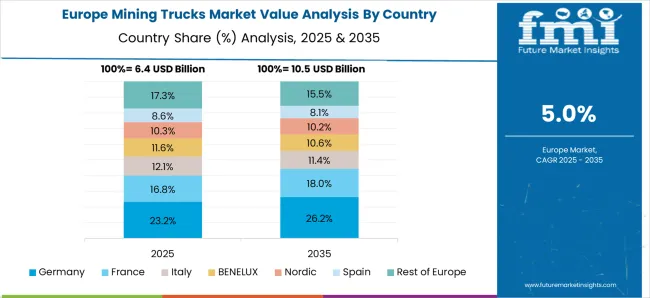
France is projected to achieve a CAGR of 5.8% during 2025–2035, supported by the country's ongoing mining activities and infrastructure development. From 2020 to 2024, the market grew at a CAGR of 5.0%, driven by demand from the construction, energy, and mining sectors. The growth in France’s mining trucks market is tied to large-scale industrial projects and investments in raw material extraction. France’s focus on sustainability in mining and green energy projects is expected to drive the adoption of more efficient and environmentally friendly mining trucks in the coming years.
The UK mining truck market is expected to grow at a CAGR of 5.2% during 2025–2035, following a CAGR of 4.8% from 2020 to 2024. The market will experience increased demand driven by large-scale mining operations and the focus on infrastructure development. The UK government’s emphasis on resource extraction, energy, and construction projects will push for more efficient and advanced mining truck solutions. Furthermore, the ongoing trend toward automation and the demand for energy-efficient equipment are expected to drive growth in the UK mining truck market, contributing to long-term expansion.
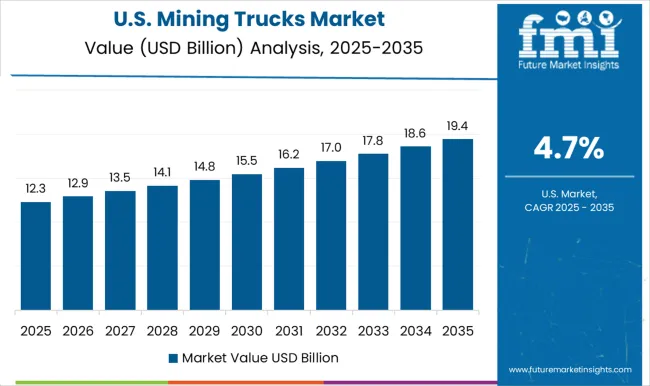
The USA mining truck market is projected to grow at a CAGR of 4.7% during 2025–2035, slightly below the global average. The market grew at a CAGR of 4.3% during 2020 to 2024, supported by the rise in mining activities across the USA, particularly in coal, oil, and gas sectors. The demand for mining trucks is expected to increase as the USA focuses on expanding its resource extraction industry and modernizing its infrastructure. Additionally, the rise in energy efficiency and automation trends in the mining sector will further support the growth of mining truck demand.
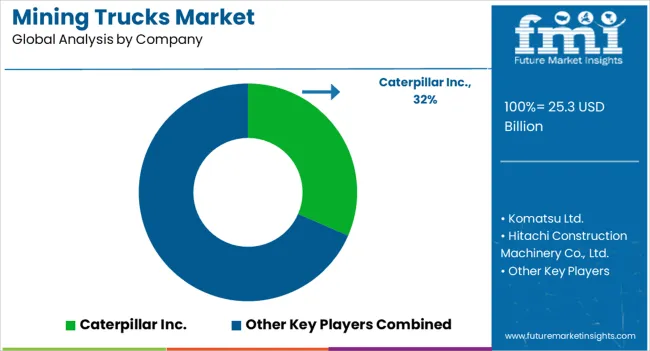
The mining trucks market is driven by global leaders such as Caterpillar Inc., Komatsu Ltd., Hitachi Construction Machinery Co., Ltd., Liebherr Group, Volvo Group, Terex Corporation, XCMG Group, SANY Group, Doosan Corporation, and Hyundai Construction Equipment. These companies dominate the sector by offering robust, efficient, and technologically advanced mining truck solutions that cater to heavy-duty transportation needs in mining, construction, and infrastructure sectors. Caterpillar Inc. remains a market leader with its extensive range of high-performance mining trucks, known for their durability, efficiency, and ability to operate in the harshest mining environments. Komatsu Ltd. follows with its heavy-duty trucks that focus on fuel efficiency, reduced emissions, and strong safety features, appealing to both large-scale mining operations and smaller operators. Hitachi Construction Machinery Co., Ltd. continues to grow its presence with a focus on versatile, all-terrain mining trucks and advanced operator comfort features. Liebherr Group and Volvo Group are increasingly leading in the European market, with innovations in autonomous and fuel-efficient trucks that are designed for maximum productivity. Terex Corporation specializes in versatile mining solutions, providing both articulated and rigid dump trucks. XCMG Group and SANY Group continue to gain ground in emerging markets by offering cost-effective and durable mining trucks. Doosan Corporation and Hyundai Construction Equipment are also competitive players, focusing on advanced technologies and energy-efficient solutions.
| Item | Value |
|---|---|
| Quantitative Units | USD 25.3 Billion |
| Mode of Operation | Autonomous and Manual |
| Trucks | Rigid frame haul trucks, Articulated haul trucks, Off-highway trucks, and Underground mining trucks |
| Payload Capacity | Less than 100 tons, 100-200 tons, 200-300 tons, and Above 300 tons |
| Propulsion | Diesel, Hybrid electric, and Others |
| Regions Covered | North America, Europe, Asia-Pacific, Latin America, Middle East & Africa |
| Country Covered | United States, Canada, Germany, France, United Kingdom, China, Japan, India, Brazil, South Africa |
| Key Companies Profiled | Caterpillar Inc., Komatsu Ltd., Hitachi Construction Machinery Co., Ltd., Liebherr Group, Volvo Group, Terex Corporation, XCMG Group, SANY Group, Doosan Corporation, and Hyundai Construction Equipment |
| Additional Attributes | Dollar sales, market share by region and segment, and demand drivers such as infrastructure development and resource extraction growth. |
The global mining trucks market is estimated to be valued at USD 25.3 billion in 2025.
The market size for the mining trucks market is projected to reach USD 43.2 billion by 2035.
The mining trucks market is expected to grow at a 5.5% CAGR between 2025 and 2035.
The key product types in mining trucks market are autonomous and manual.
In terms of trucks, rigid frame haul trucks segment to command 42.6% share in the mining trucks market in 2025.






Our Research Products

The "Full Research Suite" delivers actionable market intel, deep dives on markets or technologies, so clients act faster, cut risk, and unlock growth.

The Leaderboard benchmarks and ranks top vendors, classifying them as Established Leaders, Leading Challengers, or Disruptors & Challengers.

Locates where complements amplify value and substitutes erode it, forecasting net impact by horizon

We deliver granular, decision-grade intel: market sizing, 5-year forecasts, pricing, adoption, usage, revenue, and operational KPIs—plus competitor tracking, regulation, and value chains—across 60 countries broadly.

Spot the shifts before they hit your P&L. We track inflection points, adoption curves, pricing moves, and ecosystem plays to show where demand is heading, why it is changing, and what to do next across high-growth markets and disruptive tech

Real-time reads of user behavior. We track shifting priorities, perceptions of today’s and next-gen services, and provider experience, then pace how fast tech moves from trial to adoption, blending buyer, consumer, and channel inputs with social signals (#WhySwitch, #UX).

Partner with our analyst team to build a custom report designed around your business priorities. From analysing market trends to assessing competitors or crafting bespoke datasets, we tailor insights to your needs.
Supplier Intelligence
Discovery & Profiling
Capacity & Footprint
Performance & Risk
Compliance & Governance
Commercial Readiness
Who Supplies Whom
Scorecards & Shortlists
Playbooks & Docs
Category Intelligence
Definition & Scope
Demand & Use Cases
Cost Drivers
Market Structure
Supply Chain Map
Trade & Policy
Operating Norms
Deliverables
Buyer Intelligence
Account Basics
Spend & Scope
Procurement Model
Vendor Requirements
Terms & Policies
Entry Strategy
Pain Points & Triggers
Outputs
Pricing Analysis
Benchmarks
Trends
Should-Cost
Indexation
Landed Cost
Commercial Terms
Deliverables
Brand Analysis
Positioning & Value Prop
Share & Presence
Customer Evidence
Go-to-Market
Digital & Reputation
Compliance & Trust
KPIs & Gaps
Outputs
Full Research Suite comprises of:
Market outlook & trends analysis
Interviews & case studies
Strategic recommendations
Vendor profiles & capabilities analysis
5-year forecasts
8 regions and 60+ country-level data splits
Market segment data splits
12 months of continuous data updates
DELIVERED AS:
PDF EXCEL ONLINE
Mining Dump Trucks Market Size and Share Forecast Outlook 2025 to 2035
Mining Lubricant Market Size and Share Forecast Outlook 2025 to 2035
Mining Remanufacturing Component Market Forecast Outlook 2025 to 2035
Mining Hose Market Size and Share Forecast Outlook 2025 to 2035
Mining Equipment Industry Analysis in Latin America Size and Share Forecast Outlook 2025 to 2035
Mining Tester Market Size and Share Forecast Outlook 2025 to 2035
Mining Pneumatic Saw Market Size and Share Forecast Outlook 2025 to 2035
Trucks Market Size and Share Forecast Outlook 2025 to 2035
Mining Drilling Service Market Size and Share Forecast Outlook 2025 to 2035
Mining Shovel Market Analysis - Size, Share, and Forecast Outlook 2025 to 2035
Mining Flotation Chemicals Market Size, Growth, and Forecast 2025 to 2035
Mining Drill Market Growth – Trends & Forecast 2025 to 2035
Mining Explosives Consumables Market Growth – Trends & Forecast 2025 to 2035
Mining & Construction Drilling Tools Market Growth – Trends & Forecast 2024-2034
Mining Locomotive Market
Mining Vehicle AC Kits Market
Mining Collectors Market Size & Demand 2022 to 2032
Demining Tool Kits Market Size and Share Forecast Outlook 2025 to 2035
Hand Trucks And Dollies Market Size and Share Forecast Outlook 2025 to 2035
Dump Trucks Market Size and Share Forecast Outlook 2025 to 2035

Thank you!
You will receive an email from our Business Development Manager. Please be sure to check your SPAM/JUNK folder too.
Chat With
MaRIA